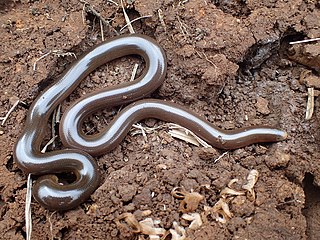
The Anomalepididae are a family of nonvenomous snakes, native to Central and South America. They are similar to Typhlopidae, except that some species possess a single tooth in the lower jaw. Currently, four genera and 15 species are recognized.

Typhlops is a genus of blind snakes in the family Typhlopidae. The genus is endemic to the West Indies. Some species which were formerly placed in the genus Typhlops have been moved to the genera Afrotyphlops, Amerotyphlops, Anilios, Antillotyphlops, Argyrophis, Cubatyphlops, Indotyphlops, Letheobia, Madatyphlops, Malayotyphlops, and Xerotyphlops.

Rhinotyphlops is a genus of blind snakes in the family Typhlopidae. The genus is found in Africa, the Middle East, and India. Some species formerly assigned to the genus Rhinotyphlops have been moved to the genera Afrotyphlops and Letheobia.

The Scolecophidia, commonly known as blind snakes or thread snakes, are an infraorder of snakes. They range in length from 10 to 100 centimetres. All are fossorial. Five families and 39 genera are recognized. The Scolecophidia infraorder is most likely paraphyletic.

Bibron's blind snake is a species of snake in the family Typhlopidae. The species is native to southern Africa.
The blotched blind snake is a species of snake in the Typhlopidae family.
The wedge-snouted blind snake, also known as the wedgenose blind snake, is a species of snake in the Typhlopidae family.
The lowland beaked blind snake is a species of snake in the Gerrhopilidae family.

The elegant blind snake, also called the elegant worm snake, is a species of snake in the Typhlopidae family. It was described by Wilhelm Peters in 1868. The species occurs on the island of Príncipe in São Tomé and Príncipe.
Gierra's blind snake, also called an Usambara spotted blind snake, is a species of snake in the family Typhlopidae.
The lined blind snake, also known as the common lined blind snake, common lined worm snake, or lineolate blind snake, is a species of snake in the family Typhlopidae. It is widely distributed in Sub-Saharan Africa, from Senegal in the west to Ethiopia in the east and Angola and Zambia in the south.
Schmidt's blind snake is a species of snake in the family Typhlopidae. The species is endemic to Central and Southern Africa.

Afrotyphlops schlegelii, commonly known as Schlegel's beaked blind snake or Schlegel's giant blind snake, is a species of snake in the family Typhlopidae. The species is endemic to eastern and southern Africa, and bears the distinction of being the world's largest typhlopid. It is harmless to humans and lives exclusively on a diet of termites.

Afrotyphlops is a genus of snakes in the family Typhlopidae.
The Somali giant blind-snake, also known as the angle-snouted blind snake, is a species of snake in the Typhlopidae family. It is found in South Sudan, southern Ethiopia, Somalia, Uganda, and northern Kenya.
Chirio's blind snake is a species of snake in the family Typhlopidae.
The Kaimosi blind snake is a species of snake in the family Typhlopidae.
The Liberian blind snake is a species of snake in the Typhlopidae family.
The Liwale blind-snake is a species of snake in the family Typhlopidae. It is endemic to southeastern Tanzania.
The Usambara blotched blind-snake is a species of snake in the Typhlopidae family.








